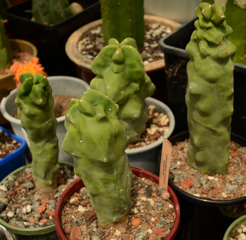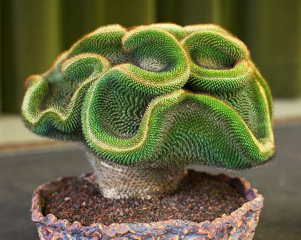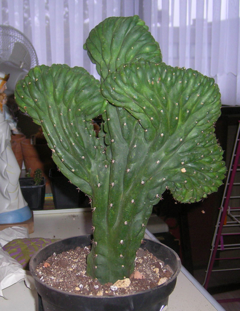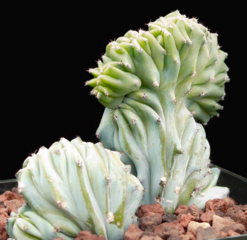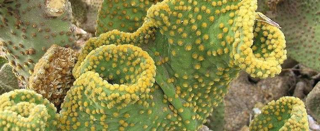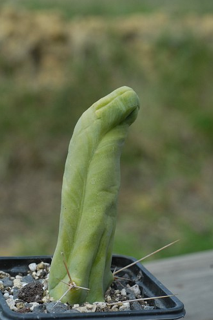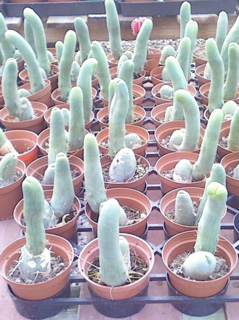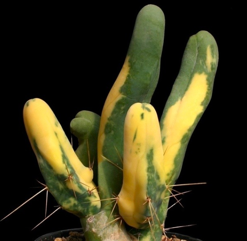Submitted by: Jim Tanner
[Ed: Same text used for both Cactus and Succulent this month]
Crested and monstrose is the occurrence of growth mutations throughout the plant kingdom, but we happen to be most interested in the topic as it applies to succulents, especially cacti and euphorbias, aeoniums, echeverias, and other succulents too.
Crested and monstrose plants are those that exhibit abnormal, distorted or disfigured growth. This happens when a mutation occurs during cell division. But rather than perfectly flat layers of tissue resulting, the damage to the central growing point creates multiple growing points that crowd and push against each other. Peculiar shapes form from this energy — such as those resembling brains, fans, coral, and snakes.
In monstrose growth, the mutation typically makes random multiple growing points that are not stacked next to each other — there’s one here, another over there, pushing the body of the plant all out of shape in disorderly fashion. The crested and monstrose forms generally occur because of injuries to the plant at a young age. In reaction to this injury, the cells at the tip of the branch where growth occurs begin to multiply at a much faster rate and the normal growing tip creates crested plants.
In monstrose specimens, each of those growth tips behaves as if it were the primary point. The result is messy, lumpy, monster-like growth. Cristates look more neat and symmetrical in comparison.
Plants can exhibit mutated and regular growth at the same time. Crests and monstrose growth are unpredictable; no two are precisely alike. That goes for plants of the same species.
LATIN LOOKUP – Loquerisne Latine (Do you speak Latin)?
The meanings of latin plant names on this page – from http://davesgarden.com/guides/botanary/
- cristata [kris-TAY-tuh]
Crested. - Echinopsis [ek-in-OP-sis]
From the Greek echinos (sea urchin or hedgehog) and opsis (like), referring to the plant’s resemblance to sea urchins. - geometrizans [jee-oh-MET-rih-zans]
Geometric; having markings in a formal pattern. - Lophocereus [lof-oh-KER-ee-us]
From the Greek lophos (crest) cereus (genus name for cactus, meaning torch). - Mammillaria [mam-mil-AR-ee-uh]
Nipple- or teat-like. - microdasys [my-kro-DAS-is]
Small and bushy. - monstrosus [mon-STROH-sus]
Strange, wonderful; monstrous; also spelled monstruosus. - Myrtillocactus [mir-til-oh-KAK-tus]
From the Greek myrtillus (small myrtle) and cactus; referring to the myrtle-like fruits. - mystax [MY-staks]
From the Latin, meaning moustache. - Opuntia [op-UN-shee-a, op-UN-tee-a]
Named after Opus (Greece), an area where other cactus-like plants were grown. - pallida [PAL-lid-duh]
Pale, pallid. - schottii [SHOT-ee-eye]
Named for Arthur Carl Victor Schott, 19th century German-born naturalist on the Mexican boundary survey.
